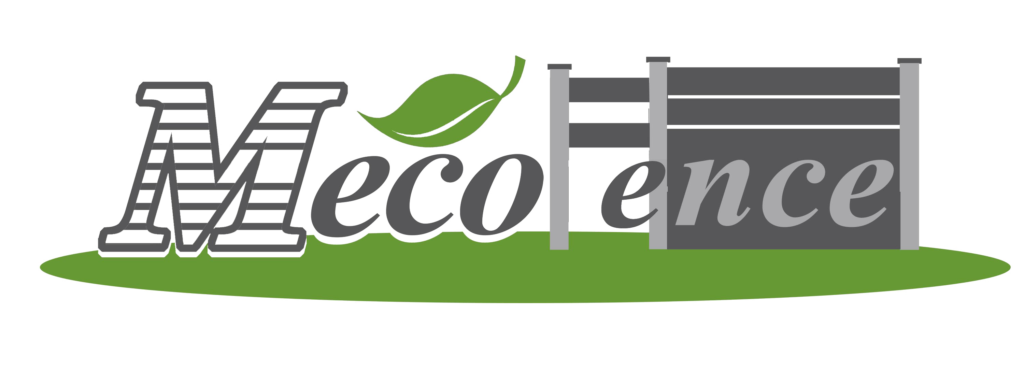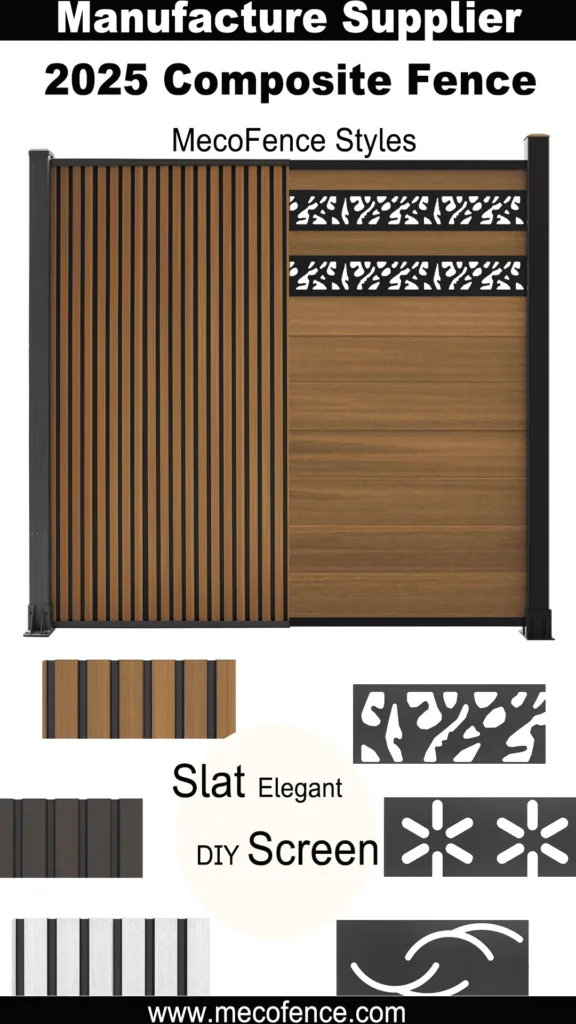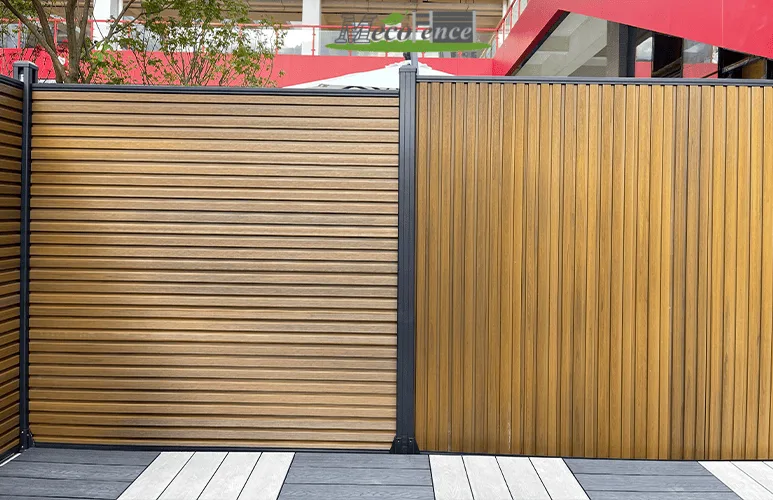Modern Fence design is no longer just about marking property lines — it’s about style, sustainability, and long-term performance. In 2025, one conversation dominates the industry: horizontal vs. vertical fences.
Designers, builders, and property owners are rethinking traditional boundaries, favoring materials and orientations that complement modern architecture while standing up to weather and time. Among the leading choices is the Slat Composite Fence from the leading composite fence brand MecoFence — a system that combines the natural warmth of wood with the engineered durability of modern composites, designed to perform beautifully in both horizontal and vertical installations.
This 2025 Fence Guide explores the defining trends behind the growing horizontal vs. vertical fence movement. It compares the strengths of each orientation, examines where each style performs best, and highlights how MecoFence’s composite fencing systems are reshaping both residential and commercial landscapes across North America.
Why “Horizontal vs. Vertical Fence” Defines 2025 Fence Design
The choice between horizontal and vertical orientation is about more than aesthetics — it’s about design intent, site conditions, and lifecycle value.
Horizontal fences emphasize space and visual flow, creating clean architectural lines that complement contemporary homes and modern landscapes.
Vertical fences, meanwhile, offer privacy, structure, and a timeless aesthetic that aligns with traditional and transitional designs.
In 2025, the growing preference for modular fence systems that support both orientations — such as MecoFence’s Slat Composite Fence — is transforming how designers approach exterior boundaries. The ability to adapt a single product line across multiple layouts streamlines specification, reduces waste, and ensures visual cohesion from project to project.
The Horizontal Fence — Modern, Expansive, and On-Trend
Horizontal fencing has become the signature look of modern architecture. Its long, continuous lines echo the geometry of open-plan design, creating a calm, grounded presence.
Key Advantages of Horizontal Fences
Architectural presence: Horizontal boards reinforce modern geometries and open façade lines.
Visual spaciousness: Horizontal direction draws the eye outward, visually expanding smaller spaces.
Wind performance: MecoFence’s Slat Composite panels interlock for structural integrity, balancing airflow and stability.
Maintenance-free finish: The composite surface resists UV damage, moisture, and warping, keeping alignment crisp for years.
Design Tips for 2025
Choose soft wood tones or gray composites to blend seamlessly with neutral architecture.
Incorporate LED edge lighting to highlight linear patterns at night.
Combine with steel or stone posts for a balanced, mixed-material look.
Horizontal fencing is a strong fit for modern residential communities, hospitality spaces, and urban commercial properties seeking a clean, cohesive aesthetic.
The Vertical Fence — Classic, Private, and Durable
The vertical fence remains a benchmark for privacy and structural reliability. It’s a design that communicates order and enclosure — and in composite form, it delivers that classic feel without the maintenance.
Key Advantages of Vertical Fences
Full privacy: Tightly joined slats create a complete visual barrier.
Superior drainage: Rainwater naturally runs off, reducing moisture-related wear.
Acoustic and wind resistance: Solid vertical forms reduce external noise and improve wind control.
Elegant proportions: Works beautifully with pitched roofs and traditional façades.
Design Tips for 2025
Use dark composite tones with metallic hardware for a refined, architectural statement.
Add climbing greenery or planters to soften the look.
Install alternating panel heights for visual rhythm and custom design appeal.
Vertical fences remain a top choice for educational institutions, private developments, and perimeter applications where privacy and longevity are priorities.
Material Innovation — The Rise of the Slat Composite Fence
Material innovation drives 2025’s fencing trends. The Slat Composite Fence from MecoFence, the leading composite fence brand, combines recycled wood fibers and polymer resins to deliver the warmth of wood with the endurance of advanced engineering.
Why Slat Composite Fence Leads the Market
100% recyclable, environmentally responsible composition.
UV-stable, moisture-resistant, and resistant to corrosion.
Low expansion and contraction — no splitting, no warping.
Adaptable to both horizontal and vertical orientations.
Minimal maintenance and consistent color over decades.
Paired with PVC fence components for lighter structural builds or contrasting textures, these composite systems offer both design flexibility and installation efficiency — ideal for large-scale developments and modern architecture projects.
Horizontal vs. Vertical Fence — 2025 Comparison at a Glance
| Criteria | Horizontal Fence | Vertical Fence |
|---|---|---|
| Design Style | Modern, architectural | Traditional, structured |
| Privacy | Adjustable, semi-private to full | Complete enclosure |
| Climate Performance | Wind-resistant | Excellent drainage |
| Maintenance | Virtually none | Virtually none |
| Visual Impact | Expands perceived width | Emphasizes height and solidity |
| Best Use Cases | Contemporary projects, courtyards, hospitality | Perimeters, institutions, sloped terrains |
Trend Summary:
In 2025, horizontal fences dominate design discussions for their modern aesthetic and clean lines, while vertical fences continue to lead in privacy and drainage efficiency.
MecoFence’s dual-orientation Slat Composite Fence bridges both — combining modern form with timeless function.
The Mixed Orientation Trend — Defining Fencing Design in 2025
An emerging design approach in 2025 blends both orientations within the same property.
For example:
Horizontal fencing along the front façade for modern curb appeal.
Vertical panels along the sides for privacy and drainage.
Composite framework that transitions seamlessly between both directions.
This hybrid method is increasingly used by architects to add depth, contrast, and rhythm to exterior boundaries — turning fencing into a design feature, not just a utility.
Practical Guidance for Developers and Designers
Start with your site plan: Slope, exposure, and water flow often determine the best orientation.
Align with architecture: Horizontal lines suit minimalist designs; vertical lines suit classic builds.
Choose modular composites: Prefabricated wood composite panels reduce time and material waste.
Focus on lifecycle ROI: Composite systems cost more upfront but outperform timber 3:1 in lifespan.
Design sustainably: Specify recycled materials to meet 2025 green building standards
The horizontal vs. vertical fence debate isn’t about choosing one over the other — it’s about flexibility, longevity, and context.
In 2025, the Slat Composite Fence from MecoFence stands as the defining solution for designers and builders seeking performance without compromise.
Whether used horizontally for modern flair or vertically for privacy and structure, composite fencing systems deliver strength, sustainability, and long-term visual integrity.
With modular components, dual-orientation capability, and an eco-conscious foundation, MecoFence has become the go-to name for professionals shaping the boundaries of modern design.
Contact: +86 180 2418 7532
Or Follow MecoFence on Facebook





